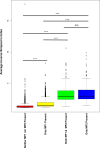Unique roles of vaginal Megasphaera phylotypes in reproductive health
- PMID: 34898422
- PMCID: PMC8767330
- DOI: 10.1099/mgen.0.000526
Unique roles of vaginal Megasphaera phylotypes in reproductive health
Abstract
The composition of the human vaginal microbiome has been extensively studied and is known to influence reproductive health. However, the functional roles of individual taxa and their contributions to negative health outcomes have yet to be well characterized. Here, we examine two vaginal bacterial taxa grouped within the genus Megasphaera that have been previously associated with bacterial vaginosis (BV) and pregnancy complications. Phylogenetic analyses support the classification of these taxa as two distinct species. These two phylotypes, Megasphaera phylotype 1 (MP1) and Megasphaera phylotype 2 (MP2), differ in genomic structure and metabolic potential, suggestive of differential roles within the vaginal environment. Further, these vaginal taxa show evidence of genome reduction and changes in DNA base composition, which may be common features of host dependence and/or adaptation to the vaginal environment. In a cohort of 3870 women, we observed that MP1 has a stronger positive association with bacterial vaginosis whereas MP2 was positively associated with trichomoniasis. MP1, in contrast to MP2 and other common BV-associated organisms, was not significantly excluded in pregnancy. In a cohort of 52 pregnant women, MP1 was both present and transcriptionally active in 75.4 % of vaginal samples. Conversely, MP2 was largely absent in the pregnant cohort. This study provides insight into the evolutionary history, genomic potential and predicted functional role of two clinically relevant vaginal microbial taxa.
Keywords: BV; Megasphaera; trichomoniasis; vaginal microbiome.
Conflict of interest statement
The authors declare that there are no conflicts of interest.
Figures






Similar articles
-
A Description of the THRIVE (The Study of Host-Bacterial Relationships and Immune Function in Different Vaginal Environments) Bacterial Vaginosis Observational Study.J Obstet Gynaecol Can. 2024 Dec;46(12):102667. doi: 10.1016/j.jogc.2024.102667. Epub 2024 Oct 2. J Obstet Gynaecol Can. 2024. PMID: 39362489
-
Stage of pregnancy impacts the bacterial communities of reproductive and placental tissues in gilts.J Anim Sci. 2025 Jan 4;103:skaf159. doi: 10.1093/jas/skaf159. J Anim Sci. 2025. PMID: 40336167
-
Douching cessation and molecular bacterial vaginosis: a reanalysis of archived specimens.Sex Transm Infect. 2023 May;99(3):156-161. doi: 10.1136/sextrans-2022-055459. Epub 2022 May 30. Sex Transm Infect. 2023. PMID: 35636931 Free PMC article.
-
Antibiotics for treating bacterial vaginosis in pregnancy.Cochrane Database Syst Rev. 2013 Jan 31;2013(1):CD000262. doi: 10.1002/14651858.CD000262.pub4. Cochrane Database Syst Rev. 2013. PMID: 23440777 Free PMC article.
-
The Black Book of Psychotropic Dosing and Monitoring.Psychopharmacol Bull. 2024 Jul 8;54(3):8-59. Psychopharmacol Bull. 2024. PMID: 38993656 Free PMC article. Review.
Cited by
-
Investigating the immunomodulatory effects of honeybee venom peptide apamin in Drosophila platforms.Infect Immun. 2025 Jul 8;93(7):e0013125. doi: 10.1128/iai.00131-25. Epub 2025 Jun 5. Infect Immun. 2025. PMID: 40470946 Free PMC article.
-
Pre- and post-LEEP: analysis of the female urogenital tract microenvironment and its association with sexual dysfunction.Sex Med. 2023 Aug 14;11(4):qfad039. doi: 10.1093/sexmed/qfad039. eCollection 2023 Aug. Sex Med. 2023. PMID: 37588087 Free PMC article.
-
Veillonellaceae family members uniquely alter the cervical metabolic microenvironment in a human three-dimensional epithelial model.NPJ Biofilms Microbiomes. 2021 Jul 6;7(1):57. doi: 10.1038/s41522-021-00229-0. NPJ Biofilms Microbiomes. 2021. PMID: 34230496 Free PMC article.
-
Assessing the Cervicovaginal Microbiota in the Context of hrHPV Infections: Temporal Dynamics and Therapeutic Strategies.mBio. 2022 Oct 26;13(5):e0161922. doi: 10.1128/mbio.01619-22. Epub 2022 Aug 18. mBio. 2022. PMID: 35980030 Free PMC article. Review.
-
Involvement of Megasphaera in the oral microbiome and dyslipidemia onset: evidence from a community-based study in Japan.Folia Microbiol (Praha). 2025 Apr 2. doi: 10.1007/s12223-025-01258-4. Online ahead of print. Folia Microbiol (Praha). 2025. PMID: 40175821
References
Publication types
MeSH terms
Substances
Grants and funding
LinkOut - more resources
Full Text Sources
Molecular Biology Databases

